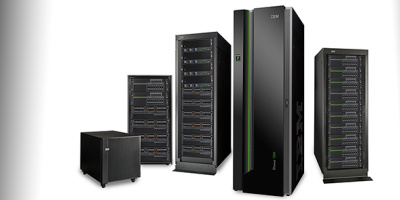Recently, I purchased a copy of Jonathan Swift’s Gulliver’s Travels and reacquainted myself with that classic. I am fascinated by Gulliver changing size as he travels. First, he’s a giant in Lilliput, and later he turns up mouse-sized in the giant kingdom of Brobdingnag. Then 139 years later, Lewis Carroll picked up the same theme in Alice’s Adventures in Wonderland, in which Alice changed sizes—normal, then small, then big, then small again—to enter Wonderland (where she also grows and shrinks a lot). Size changing is interwoven into Western fantastic literature and you can see it in such diverse works as L. Frank Baum’s Oz books, and the classic science-fiction movies “The Incredible Shrinking Man” and “Fantastic Voyage.”
This idea also permeates the very core of our computer systems. Moore’s law, which states that processing power doubles every 18 months while cost holds constant, is a classic Gulliver/Alice/late-night horror movie example. We take something big in terms of processing power and shrink its physical dimensions, desktop footprint, and cost. The big becomes small and fairy tales become reality.
IBM follows this archetype just as well as anyone else, performing some unusual shrinking acts in two very large AS/400 networking enhancements. What is IBM’s Server Consolidation strategy, if not another shrinking act? Want to pack multiple Windows NT servers into a single AS/400? That’s no problem with Windows NT Integration and the Integrated NetFinity Server (INS, formerly known as the IPCS). Want to shrink the number of physical AS/400s in your organization? You can squeeze multiple AS/400s into a single black box via OS/400 V4R4 and Logical Partitioning (LPAR). To make it sweeter, you can manage your “virtual” AS/400s through the Operations Navigator’s Management Central function.
And what about AS/400 Client Access Express for Windows (Express client), IBM’s next generation Client Access, whose predecessor had five major releases since 1996 and multiple service packs for each release, producing at least 25 different product versions along the way? Along comes Express client, and IBM’s feature-bloated Windows 95/NT client suddenly becomes tiny.
This same analogy can also be applied to Windows NT, Novell NetWare, and other networking products that are currently producing new betas and new versions. When a product becomes too big, too rich, too complicated, or too behind the times, the software life cycle demands that the manufacturer retool, rethink, and reissue the package in a smaller container that can be marketed as new. The fact that so many products—from
Express client to Microsoft Windows 2000 to Office 2000 to NetWare for SAA 4.0—have reached this point at the same time speaks volumes about the computer industry.
With so many vendors issuing new products/betas simultaneously, I wonder why this is happening now. Does our industry now run on the same product maturation cycle so that all networking products warrant new releases today, in spring 1999? It’s curiouser and curiouser that we’re experiencing a product upgrade explosion just as our shops are preparing for that highly anticipated train wreck called Y2K. Perhaps there’s some secret paradigm shift at work that’s forcing our AS/400 network vendors to retool or die. Whatever’s happening, it’s also forcing AS/400 networking managers to evaluate new options at a time when their main hope is to survive January 1, 2000 intact.
But—with all these new product releases as Y2K approaches—one thing remains unchanged. The cardinal rule of networking is still in force: keep the network going. It doesn’t matter what hot new technologies are available if the network isn’t available come January 1st. We must not be distracted when a clearly defined problem must be solved. Batten down your networks first. Look at new products later. Otherwise, it might be your organization that shrinks. And it won’t be Wonderland that’s waiting for you this time.




















 More than ever, there is a demand for IT to deliver innovation. Your IBM i has been an essential part of your business operations for years. However, your organization may struggle to maintain the current system and implement new projects. The thousands of customers we've worked with and surveyed state that expectations regarding the digital footprint and vision of the company are not aligned with the current IT environment.
More than ever, there is a demand for IT to deliver innovation. Your IBM i has been an essential part of your business operations for years. However, your organization may struggle to maintain the current system and implement new projects. The thousands of customers we've worked with and surveyed state that expectations regarding the digital footprint and vision of the company are not aligned with the current IT environment. TRY the one package that solves all your document design and printing challenges on all your platforms. Produce bar code labels, electronic forms, ad hoc reports, and RFID tags – without programming! MarkMagic is the only document design and print solution that combines report writing, WYSIWYG label and forms design, and conditional printing in one integrated product. Make sure your data survives when catastrophe hits. Request your trial now! Request Now.
TRY the one package that solves all your document design and printing challenges on all your platforms. Produce bar code labels, electronic forms, ad hoc reports, and RFID tags – without programming! MarkMagic is the only document design and print solution that combines report writing, WYSIWYG label and forms design, and conditional printing in one integrated product. Make sure your data survives when catastrophe hits. Request your trial now! Request Now. Forms of ransomware has been around for over 30 years, and with more and more organizations suffering attacks each year, it continues to endure. What has made ransomware such a durable threat and what is the best way to combat it? In order to prevent ransomware, organizations must first understand how it works.
Forms of ransomware has been around for over 30 years, and with more and more organizations suffering attacks each year, it continues to endure. What has made ransomware such a durable threat and what is the best way to combat it? In order to prevent ransomware, organizations must first understand how it works. Disaster protection is vital to every business. Yet, it often consists of patched together procedures that are prone to error. From automatic backups to data encryption to media management, Robot automates the routine (yet often complex) tasks of iSeries backup and recovery, saving you time and money and making the process safer and more reliable. Automate your backups with the Robot Backup and Recovery Solution. Key features include:
Disaster protection is vital to every business. Yet, it often consists of patched together procedures that are prone to error. From automatic backups to data encryption to media management, Robot automates the routine (yet often complex) tasks of iSeries backup and recovery, saving you time and money and making the process safer and more reliable. Automate your backups with the Robot Backup and Recovery Solution. Key features include: Business users want new applications now. Market and regulatory pressures require faster application updates and delivery into production. Your IBM i developers may be approaching retirement, and you see no sure way to fill their positions with experienced developers. In addition, you may be caught between maintaining your existing applications and the uncertainty of moving to something new.
Business users want new applications now. Market and regulatory pressures require faster application updates and delivery into production. Your IBM i developers may be approaching retirement, and you see no sure way to fill their positions with experienced developers. In addition, you may be caught between maintaining your existing applications and the uncertainty of moving to something new. IT managers hoping to find new IBM i talent are discovering that the pool of experienced RPG programmers and operators or administrators with intimate knowledge of the operating system and the applications that run on it is small. This begs the question: How will you manage the platform that supports such a big part of your business? This guide offers strategies and software suggestions to help you plan IT staffing and resources and smooth the transition after your AS/400 talent retires. Read on to learn:
IT managers hoping to find new IBM i talent are discovering that the pool of experienced RPG programmers and operators or administrators with intimate knowledge of the operating system and the applications that run on it is small. This begs the question: How will you manage the platform that supports such a big part of your business? This guide offers strategies and software suggestions to help you plan IT staffing and resources and smooth the transition after your AS/400 talent retires. Read on to learn:
LATEST COMMENTS
MC Press Online